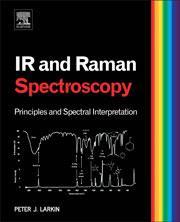IR and Raman spectroscopy: principles and spectral interpretation
IR and Raman spectroscopy: principles and spectral interpretation
Peter Larkin
Oxford, UK: Elsevier
2011 | 230pp | ?69.99 (HB)
ISBN 9780123869845
Reviewed by Geoffrey Dent

This book is refreshing in both style and content. It falls into the ’must have on the shelf’ category for all who indulge in vibrational spectroscopy. However, whilst having several excellent features, there are also a few weaknesses.
The strongest feature is the collection of interpreted and unknown spectra, which show both the infrared and Raman spectra on the same wavenumber axes. The spectra are, in the most part, fully interpreted and strongly demonstrate the complementary nature of the two techniques. On occasions, the strongest band in the Raman spectrum is not mentioned. These sections are preceded by an in depth explanation of the correlation of spectra and characteristic group frequencies, although the rather brief section on inorganic compounds is disappointing.
Other strong features are the clear explanation of Fermi resonance, an acknowledgement of the increasing use of spectral prediction software and a chapter on a strategy for interpretation. The latter underlines the need to look at all aspects of the production of a spectrum from the origin of the sample, sample preparation method, sampling accessories, instrument settings through to software manipulation and the relevance of the information required from the spectrum. Apparently missing is an acknowledgement of the significant effect of laser wavelength on Raman spectra.
Two unusual features are the use of cgs (centimetre-gram-second) units in the Classical theory section and the rather theoretical description of the ATR (attenuated total reflectance) technique. A pictorial depiction of the ATR/transmission issues is strangely absent. I must also take issue with the acceptance that water bands in KBr disks are inevitable. However these points fall into the category of niggles, and overall the book is a strong addition to the tools of vibrational spectroscopy interpretation.












No comments yet